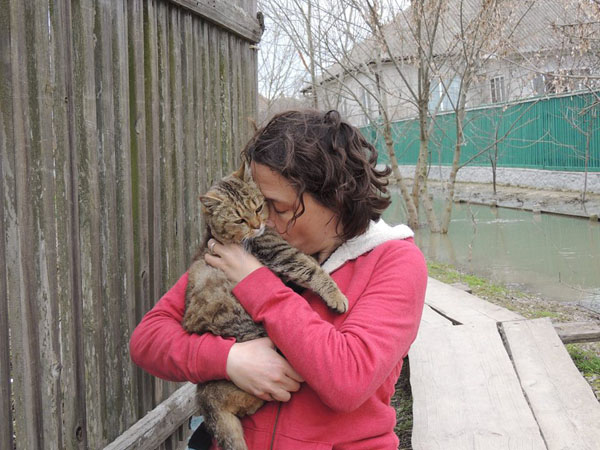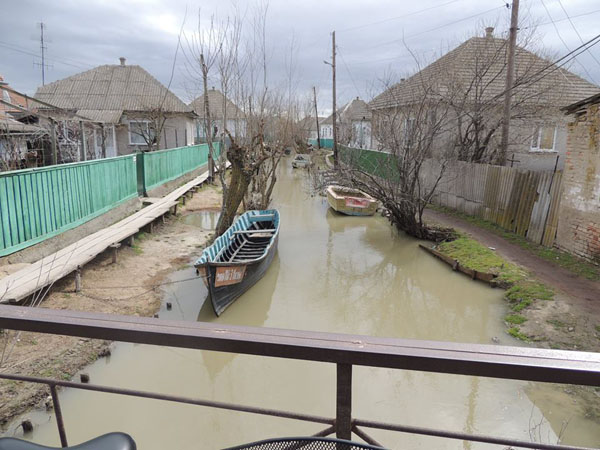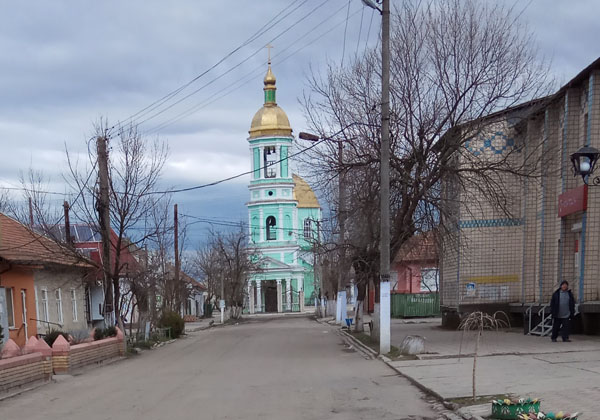|
|
|
Ukranian Venice
Sunday, April 1 2018
location: room 311, MS Joy, docked on the Danube River at Vylkove, Ukraine
We awoke this morning docked at Vylkove at the southwest corner of Ukraine, which claims a small part of the Danube delta. Like Serbia (and unike Romania), Ukraine is not in the European Union, and so there was more paperwork to be filled out before any of use could go explore the village. Parts of Ukraine in the east are still fighting an insurrection of ethnic Russians (and Russian invaders), so the country is understandably nervous at ports of entry. Still, there's nothing less intimidating than a river boat full of vegans. The Ukrainian border officials all looked like fresh-faced youngsters, even dressed in their smart green uniforms.
Gretchen and I borrowed bikes, though getting around on wheeled vehicles wasn't always easy in Vylkove. The Danube was in the midst of spring flooding, inundating riverside fields, forests, and villages. Huge puddles reached up into Vylkove's streets, though they were usually shallow enough to bike through. Vylkove's first spectacle was a smallish church with bright gold onion domes. I was sure to get some photographs from an angle suggesting it was being swallowed by floodwater.
It isn't just that Vylkove is subject to Danube flooding, it's also that it has a network of canals that serve as avenues for transportation. We crossed a pedestrian bridge and found ourselves on a path of planks along one such canal. Gretchen had said something about Vylkove being the Venice of Eastern Europe, but it's nowhere near that glamorous. The canals are narrow and shallow, lined with encroaching vegetation, and the boats are old and show signs of multiple repairs. Still, we'd never been to any place like Vylkove. It wasn't just the canals and the plank walkways, or the occasional people we encountered (several of them tanned dark brown from lives spent working outdoors). It was also the many dogs and cats we encountered. The dogs tended to be suspicious of us (but not of the locals), while one of the cats was extremely trusting, allowing Gretchen to pick him or her up immediately. One had the sense that dangers in a village like this aren't like those in a more conventional one. Dogs and cats are less likely to be hit by moving vehicles, so they're free to come and go as they please. The same is true of children. We saw a number of little girls (maybe eight or nine years old) walking home from wherever all by themselves. It's the sort of thing I used to do at that age, but you'd never see such a thing in the contemporary United States. After we left the canals and found a street to ride on, a little boy doing tricks on his bicycle tried to strike up a conversation, but we hadn't done our homework and didn't know how to say anything in Ukrainian.
In an effort to better see a bluish church with grey onion domes, we took a bridge across the Bilhorods'ke River (past a dog that appeared to have recently died) and eventually found our way to tourist destination called The Vilkovo Pelican Tour. Gretchen had the idea that we should take a boat out into the delta to look at wildlife, and she went into the headquarters to see if something could be arranged. Nobody there had much in the way of English skills, but eventually we managed to work out that there really isn't any wildlife to be seen this time of year (the pelicans, for example, have yet to arrive), so the plans fell apart. We biked to the north end of Khmelnitsky Street (вуличя Хмельницького), where the dogs rarely see strangers. A couple cuties came charging out from one of the houses to confront us, and when we started petting them, they moaned with delight. After going to the end of the street and passing by again, they charged out a second time, apparently having forgotten all about the relationship we'd established. Sniffing my hand, they stopped barking immediately, but also seemed kind of over us. Further back towards the middle of town, we encountered a graceful black dog that looked a more delicate version of our old dog Sally. Gretchen didn't want to touch her for fear of falling in love. Interesting, the dogs of Vylkove tend to be, as Gretchen put it, stumpy; their legs are short, though their bodies are normal-sized. Perhaps dwarfism confers advantages in this frequently-flooded world.
Before crossing the bridge, I noted that the possibly-dead dog was still where he or she had been before. He or she was definitely dead.
Later, back on the boat, I read about the history of Vylkove, particularly the people who had come here to flee oppression resulting from a Russian Orthodox schism in the 1600s. At that time, the Russian Orthodox Church initiated reforms to conform better with the practices of the Greek Orthodox Church, though many of the changes were arbitrary (for example, swapping mentions of "Jesus" and "the Son" in liturgy). Those who would not accept these changes are termed "Old Believers," and they've kept a separate religious tradition to this day. Many of the Old Believers fled to the Danube delta, and in Vylkovo, two of the three churches are for Old Believers.
[REDACTED]

A gold-crowned church in Vylkove. I think the cross is typical of non-Old-Believer crosses, but I could be wrong.

A Vylkove dog.

A cute cat walking on the planks along a canal.

Gretchen had to pick that cat up.

This is what the canals look like. Not so glamorous, huh?

The blue church in Vylkove.

The third Vylkove church was kind of greenish.
For linking purposes this article's URL is:
http://asecular.com/blog.php?180401 feedback
previous | next |






